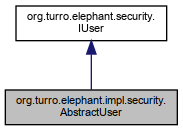

Public Member Functions | |
| AbstractUser () | |
| boolean | isInRole (String role) |
| boolean | hasAnyRoleKey (String role) |
| void | setConstructor (IConstructor constructor) |
 Public Member Functions inherited from org.turro.elephant.security.IUser Public Member Functions inherited from org.turro.elephant.security.IUser | |
| boolean | validate (String login, String password) |
| boolean | validate (String key) |
| boolean | validate2 (String password2) |
| boolean | impersonate (String login) |
| boolean | impersonateByEmail (String email) |
| boolean | isValid () |
| void | reload () |
| boolean | isThisUser (String id) |
| String | getId () |
| String | getName () |
| String | getProperty (String key) |
| boolean | equals (Object obj) |
| Map | getByDescriptors (String value) |
| boolean | hasRoleName (String role) |
| List | getUsers () |
| String | createTmpKey (Date valid) |
Protected Attributes | |
| String | name |
| IConstructor | constructor |
| boolean | superUser = false |
| UserProfileMap | upm |
Additional Inherited Members | |
 Static Public Attributes inherited from org.turro.elephant.security.IUser Static Public Attributes inherited from org.turro.elephant.security.IUser | |
| static final String | CONNECTOR_EMAIL = "Email" |
| static final String | CONNECTOR_TRADE = "TradeName" |
| static final String | CONNECTOR_FISCAL = "FiscalName" |
| static final String | CONNECTOR_EMAIL_LOGIN = "EmailLogin" |
| static final String | ADDRESS_FISCAL = "Fiscal" |
| static final String | LOGGED_USER = "xp_user" |
| static final String | INTERNAL_SIGNIN = "InternalSignIn" |
Definition at line 27 of file AbstractUser.java.
| org.turro.elephant.impl.security.AbstractUser.AbstractUser | ( | ) |
| boolean org.turro.elephant.impl.security.AbstractUser.hasAnyRoleKey | ( | String | role | ) |
Implements org.turro.elephant.security.IUser.
Definition at line 45 of file AbstractUser.java.
| boolean org.turro.elephant.impl.security.AbstractUser.isInRole | ( | String | role | ) |
Usually this method should take this form:
if(user.isInRole("page:edit")) {
// edit page
}
| role | Role to check. |
Implements org.turro.elephant.security.IUser.
Definition at line 39 of file AbstractUser.java.

| void org.turro.elephant.impl.security.AbstractUser.setConstructor | ( | IConstructor | constructor | ) |
Implements org.turro.elephant.security.IUser.
Definition at line 57 of file AbstractUser.java.
|
protected |
Definition at line 30 of file AbstractUser.java.
|
protected |
Definition at line 29 of file AbstractUser.java.
|
protected |
Definition at line 31 of file AbstractUser.java.
|
protected |
Definition at line 32 of file AbstractUser.java.